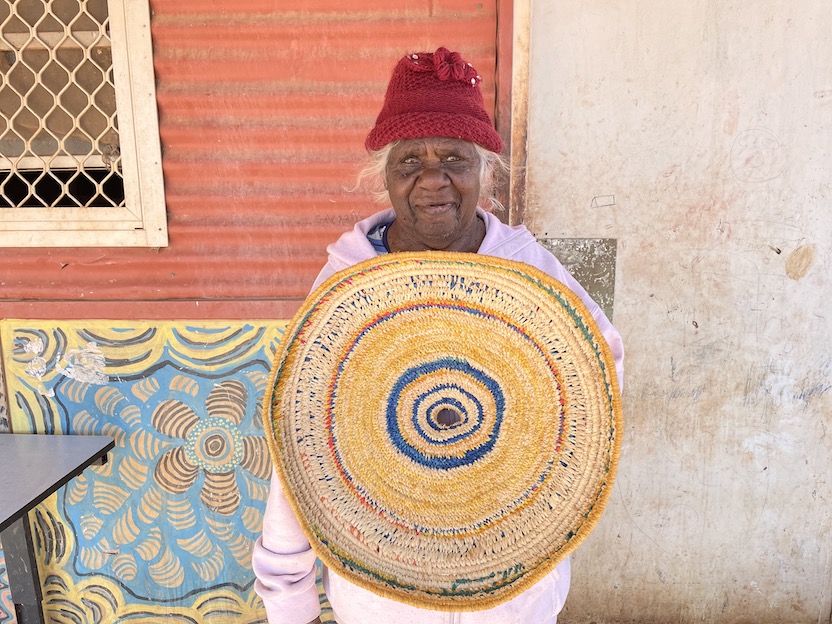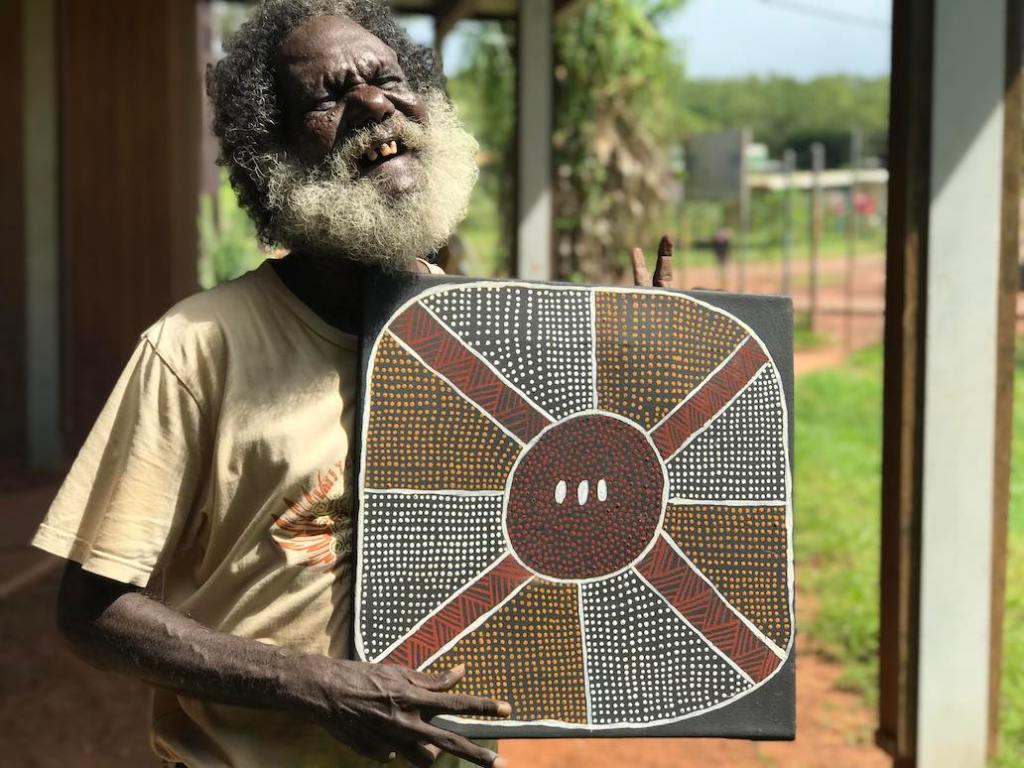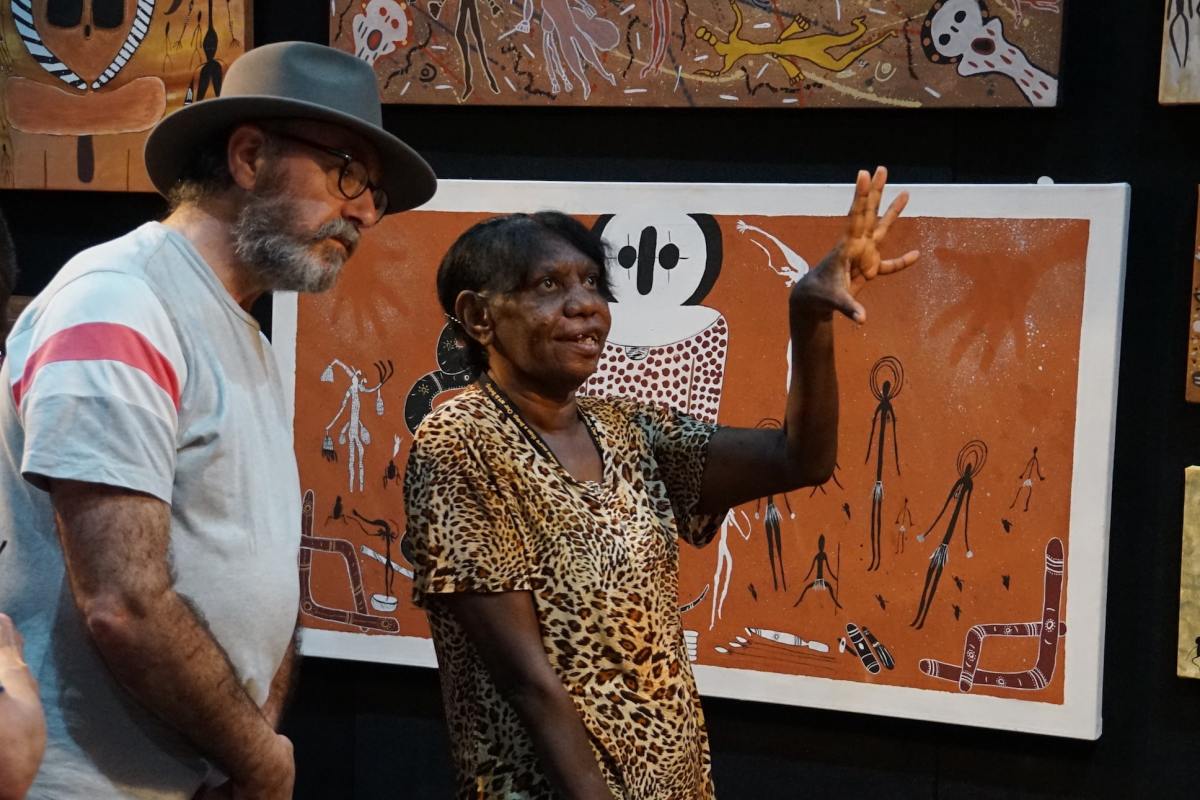As the longest, continuous Aboriginal art fair in Australia, solid ethics, open engagement and damn good creative fun, are entrenched within the Darwin Aboriginal Art Fair (DAAF).
‘We take our lead from the Art Centres themselves,’ said Shilo McNamee, the DAAF Foundation’s Artistic Director. ‘The Fair exists to support our Art Centres’ artists working on the ground, so we don’t take a commission on sold works.’
Set to stage its 16th edition on Larrakia Country in a few weeks, DAAF will be presented, in a first, as a hybrid event: that in person connection we have all been hankering for at Darwin Convention Centre 2-7 August, and online, continuing to broaden interstate and international audiences, from 5-7 August.
Seventy six Art Centres and over 1,500 artists will showcase their work at this year’s edition of DAAF, stretching from Tasmania to Torres Strait to the Tiwi Island and the Kimberley.
‘It is really the whole continent represented here, from the long established Art Centres, such as Buku-Larrnggay Mulka Centre in Yirrkala and Warlukurlangu Artists in Yuendumu – who have really established business models and collecting networks – to emerging Arts Centres coming to DAAF for the first time.
‘We are especially excited to welcome Utopia Art Centre, Juluwarlu Art Group, Ku’arlu Mangga (Good Nest), and Nyinkka Nyunyu Art and Culture Centre who are joining us for the first time,’ continued McNamee.
She said the very nature of Art Centres evolving, and a next generation of artists becoming more professionally engaged, plus the successes of going online over the past two years, has meant that DAAF is returning bigger and better than ever before.
‘Every year we keep growing the physical events, so the Fair continues to feel different from year to year as we apply our learnings, and welcome more visitors who come to immerse themselves in the oldest living cultures on earth,’ McNamee told ArtsHub.
The online platforms that DAAF developed during pandemic lockdowns has broadened audience engagement with their membership of Art Centres exponentially, not to mention the upward spike in online sales alongside more conventional markets.
In 2021, the Fair achieved a record $3.12 million in sales.
‘Our main core business is working with Art Centres, and by doing so, we ensure that we are building long term relationships between Art Centres and customers, and supporting Indigenous communities with a steady income stream,’ explained McNamee.

What to expect at DAAF 2022
Born and raised in Darwin, McNamee says August is the perfect time to visit the Top End. On top of the good weather and warm wandering through the art fairs offerings, people can engage with a vibrant Public Program of Artist Masterclasses, talks, material demonstrations and cultural performances.
‘There is something different every day; this year we have some pretty exciting workshops, such as soft sculpture making with Yarrenyty Arltere Artists, or sit with master weavers Mary Dhapalany, Evonne Munuygurr and Margaret Malibirr from Gurriwilliny (Bula’bula Arts) and learn the process of weaving a mindirr (dillybag).
‘And if you can’t get into a workshop, there are demonstrations out in the public space where people can just enjoy watching the artists working and creating with natural materials,’ added McNamee.

Unmistakably, a highlight of DAAF is its signature event Country to Couture, back for the seventh year with a high-energy runway event on 2 August, presenting collections from some of Australia’s most talented First Nations fashion designers and artists working in remote Indigenous communities.
‘It is an emerging space, but something the Arts Centres are keenly grabbing on to and doing in their own spaces, and because of that, we are seeing a lot of new textile arts,’ said McNamee.
She added that this emerging sector is ripe for collaboration with designers, and that the Fair is a great opportunity to head up and make those connections.
It is paired with the National Indigenous Fashion Awards (NIFA) which highlights the success of the Indigenous textile design movement, with an event on 3 August. The event will culminate in an award ceremony at the Deckchair Cinema in Darwin and will be later broadcast on NITV.
‘We are quite proud of our work in the Indigenous Fashion space; it’s getting more and more exposure for its innovation and diversity,’ concluded McNamee.
DAAF Foundation Executive Director, Claire Summers added: ‘With Aboriginal and Torres Strait Islander art, fashion and design experiencing a meteoric rise these last years – we feel this recognition as just the beginning and we still have a long way to go in terms of representation. Storytelling is a major part of First Nations culture and we, as Australians, still have so much to learn.’
She believes that being part of DAAF is a fantastic way of doing this.
Plan your trip to Larrakia Country for the Darwin Aboriginal Art Fair.





